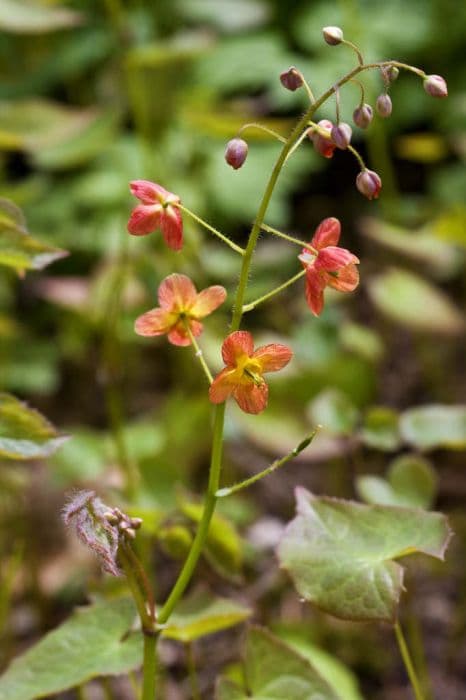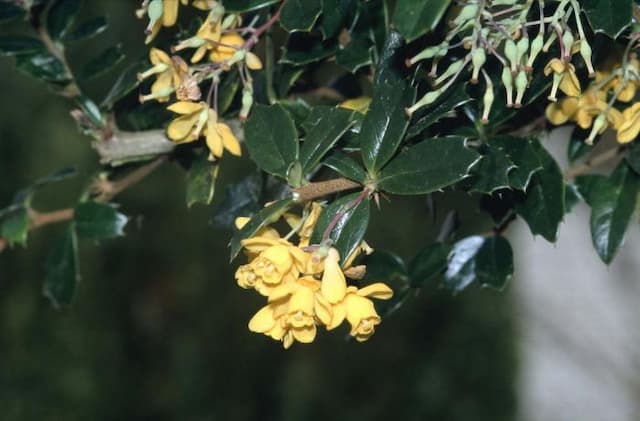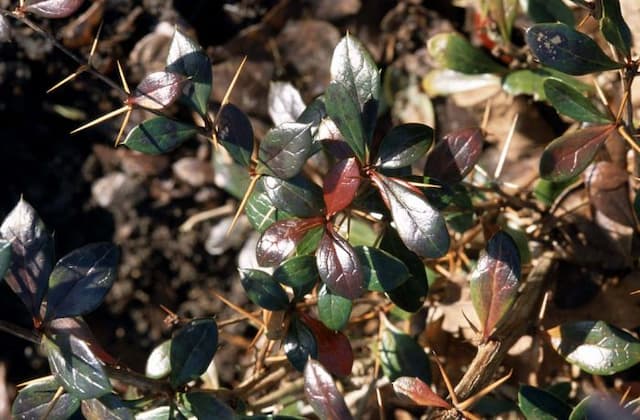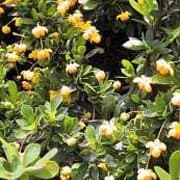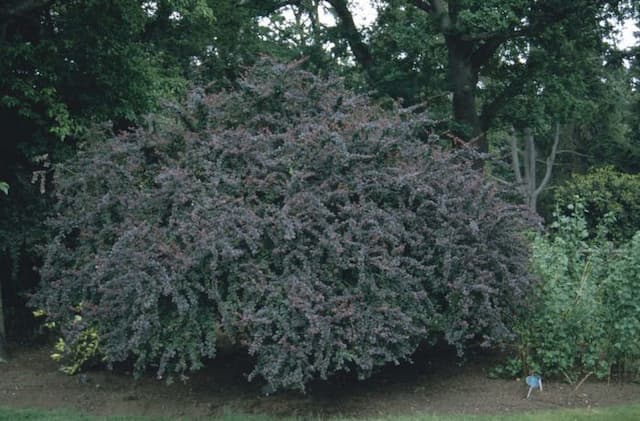Barberry Berberis 'Boughton Red'

ABOUT
Berberis 'Boughton Red', commonly known as the Red Barberry, is a striking shrub known for its deep reddish-purple foliage that typically remains vibrant throughout the growing season. The leaves are small and oval-shaped with a slightly serrated edge, creating a fine-textured appearance that softens when the plant is viewed from a distance. In the spring, this plant produces clusters of small, yellow flowers that dangle along the stems, adding a burst of contrasting color against the dark foliage. As the flowering season ends, the blossoms give way to small, red berries that are appealing to birds and other wildlife, though they should be noted to be sharp-tasting and not commonly used for human consumption. These berries persist into the winter, providing visual interest even in the colder months. The Red Barberry has a dense, compact growth habit, with branches that may possess sharp thorns, which makes it useful as a barrier plant in landscaping. The overall form of the shrub is mounded with branches that may arch slightly, adding to its visual appeal and making it a popular choice for use in garden borders, hedges, and ornamental plantings. The hardiness and the easy-care nature of this plant, along with its vibrant color and texture, make it a favored choice among gardeners and landscapers looking to add year-round interest to their spaces.
About this plant
 Names
NamesFamily
Berberidaceae
Synonyms
Boughton Red Barberry
Common names
Berberis 'Boughton Red'.
 Toxicity
ToxicityTo humans
Barberry, including the cultivar 'Boughton Red', contains certain alkaloids that may be harmful if ingested in large quantities. However, barberry as a genus is not typically considered highly toxic to humans. Still, ingestion of large amounts of the plant, especially the roots and bark, can lead to gastrointestinal issues such as nausea, vomiting, diarrhea, and in severe cases, possibly low blood pressure and lethargy. The berries, on the other hand, are generally considered edible when ripe. Though they are sour, they are sometimes used in culinary applications. It is always important to exercise caution and avoid consuming any part of garden plants unless you are sure they are safe to eat and have properly identified them.
To pets
Barberry, which includes the 'Boughton Red' variety, is not widely recognized as a highly toxic plant to pets. However, as a precautionary principle, it's suggested that pets do not ingest the plant. If pets consume small quantities, they are unlikely to experience more than minor upset stomach. Ingesting larger amounts of the plant, particularly the roots or bark, could potentially result in more serious gastrointestinal distress for pets, such as vomiting or diarrhea. As with any non-food plants, it is wise to prevent pets from chewing on or consuming parts of barberry to avoid any potential health issues.
 Characteristics
CharacteristicsLife cycle
Perennials
Foliage type
Deciduous
Color of leaves
Varies
Flower color
Yellow
Height
4-5 feet (1.2-1.5 meters)
Spread
4-6 feet (1.2-1.8 meters)
Plant type
Shrub
Hardiness zones
5-9
Native area
Asia
Benefits
 General Benefits
General Benefits- Attractive Foliage: Berberis 'Boughton Red' has red-purplish leaves that add a striking color to the landscape throughout the growing season.
- Seasonal Interest: It offers spring flowers and autumn fruits, providing visual interest throughout multiple seasons.
- Drought Tolerance: Once established, this plant is drought-resistant, making it suitable for xeriscaping or low-water gardens.
- Low Maintenance: It requires minimal care once established, making it an ideal choice for gardeners seeking low-maintenance landscaping options.
- Pest Resistance: The plant is known to be resistant to many pests, reducing the need for chemical treatments.
- Dense Growth Habit: Its dense, compact growth habit can provide excellent ground cover and can help prevent soil erosion.
- Wildlife Attraction: The berries produced can attract birds and other wildlife to your garden.
- Privacy Hedge: Can be used as a hedge or barrier due to its thorny branches, providing privacy and security.
- Adaptability: This plant can adapt to a variety of soil types, though it prefers well-drained conditions.
- Decorative Use: Its berries and colorful foliage are often used in floral arrangements and as garden highlights.
 Medical Properties
Medical PropertiesThis plant is not used for medical purposes.
 Air-purifying Qualities
Air-purifying QualitiesThis plant is not specifically known for air purifying qualities.
 Other Uses
Other Uses- Dye Production: The berries of the Berberis 'Boughton Red', commonly known as barberry, can produce a natural yellow dye, useful for coloring fabrics and yarns.
- Garden Barrier: Due to its thorns, barberry can be used as a protective hedge to deter animals and unauthorized access to private gardens.
- Photography: The barberry's striking red foliage adds aesthetic value to landscape photography, especially in the fall season.
- Soil Erosion Control: Barberry can be planted on slopes and areas prone to erosion, where its root system helps to stabilize the soil.
- Wildlife Shelter: The dense foliage of the barberry provides shelter and nesting sites for birds and other small wildlife.
- Winter Interest: Barberry adds color to the garden in winter months, maintaining visual interest when most other plants are dormant.
- Educational Tool: Botany and horticulture students can study the barberry to learn about plant growth habits, maintenance, and propagation techniques.
- Culinary Decoration: The bright red berries can be used as a natural garnish for dishes, although they should be used with caution as they are very tart.
- Feng Shui: In traditional Eastern practices, barberry can be used to create a balance of energy in the garden, aligning with feng shui principles.
- Crafts: Barberry branches, with their red foliage and berries, can be incorporated into floral arrangements and wreaths for decorative purposes.
Interesting Facts
 Feng Shui
Feng ShuiThe Barberry is not used in Feng Shui practice.
 Zodiac Sign Compitability
Zodiac Sign CompitabilityThe Barberry is not used in astrology practice.
 Plant Symbolism
Plant Symbolism- Protection: Berberis, commonly known as barberry, often has thorns and has been used in the past to create protective hedges. It symbolizes safety and a barrier against negative forces.
- Purification: Barberry has medicinal qualities and has been used to cleanse the body; symbolically, it can represent purging negativity or impurities.
- Sharpness: With its sharp thorns, barberry can symbolize a sharp mind or wit, suggesting intelligence or strategic thinking.
 Water
WaterThe Japanese Barberry should be watered deeply once a week, providing about 1 to 1.5 gallons of water for each occasion. In periods of drought or extreme heat, it may require additional water, possibly twice a week, to maintain soil moisture as this shrub prefers evenly moist but not waterlogged soil. During the cooler months or rainy seasons, reduce the frequency of watering to prevent overwatering. The root zone should be the main target when watering, avoiding wetting the foliage to prevent disease. When establishing new shrubs, they may need water more frequently until their root systems have expanded.
 Light
LightJapanese Barberry thrives best in full sun to part shade conditions. It is ideal to place it in a spot where it receives at least 6 hours of direct sunlight per day. While the shrub can tolerate some shade, too little light may result in fewer flowers and less vivid foliage color.
 Temperature
TemperatureJapanese Barberry is hardy and can tolerate a wide range of temperatures. It can survive minimum temperatures down to -30 degrees Fahrenheit. However, the ideal growing temperatures are between 60 and 70 degrees Fahrenheit. Extreme heat can stress the plant, so providing shade or additional water may be necessary when temperatures exceed 90 degrees Fahrenheit.
 Pruning
PruningPrune Japanese Barberry to maintain its shape and to remove any dead or diseased branches. The best time for pruning is late winter or early spring before new growth starts. Thinning out older branches every few years encourages better air circulation and rejuvenates the plant. Pruning can be done annually as needed.
 Cleaning
CleaningAs needed
 Soil
SoilJapanese Barberry 'Boughton Red' thrives best in well-drained, loamy soil with a pH ranging from 6.0 to 7.5. A mixture of garden soil, compost, and coarse sand or perlite can provide the necessary drainage and nutrients. Mulch can help maintain soil moisture consistency.
 Repotting
RepottingJapanese Barberry 'Boughton Red' should be repotted every two to three years to replenish nutrients and prevent it from becoming root-bound. It's best to repot in the early spring before new growth begins.
 Humidity & Misting
Humidity & MistingJapanese Barberry 'Boughton Red' is tolerant of a range of humidity conditions and is well adapted to outdoor humidity levels. It does not require specific humidity adjustments when grown in its natural outdoor environment.
 Suitable locations
Suitable locationsIndoor
Bright light, good air circ., avoid overwatering.
Outdoor
Full sun to part shade, well-drained soil, mulch base.
Hardiness zone
4-8 USDA
 Life cycle
Life cycleThe life cycle of Berberis 'Boughton Red', commonly known as Boughton Red Barberry, begins with seed germination, which requires a period of cold stratification to break dormancy. Once the seeds sprout and seedlings establish a root system, they enter a phase of vegetative growth, where they develop woody stems, spiny leaves, and a branching habit. The plant reaches maturity in a few years, producing clusters of yellow flowers in the spring, which are pollinated by insects. After pollination, the flowers develop into small, red oblong berries that mature by autumn and are often eaten by birds, which then disperse the seeds. The plant continues to grow and may spread through root suckers, leading to new shoots emerging from the base and expanding the plant's reach. Throughout its lifespan, the Boughton Red Barberry may undergo periods of pruning to maintain shape and encourage new growth, with the entire life cycle potentially spanning decades under ideal conditions.
 Propogation
PropogationPropogation time
Spring-Early Summer
The most popular method of propagating Berberis 'Boughton Red', also known as Japanese barberry, is through softwood cuttings. This technique is usually done in late spring to early summer when new growth is still flexible. Cut a piece of stem about 4 to 6 inches (10 to 15 cm) long, making sure it has a few leaves. Strip the bottom leaves off and dip the cut end into rooting hormone powder to encourage root development. The cutting should then be planted in a well-draining potting mix, ensuring that the leafless part of the stem is buried. The pot must be kept in a warm, humid environment and out of direct sunlight to prevent the cutting from drying out before it roots. Maintain consistent moisture in the soil until the cutting has rooted well, which can take several weeks.

